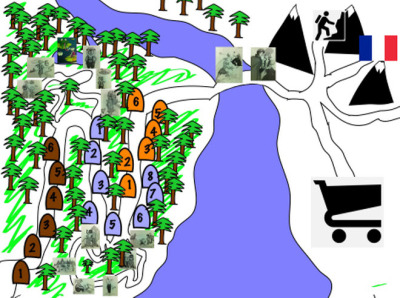Landscape/Frame/Gateway Design Model
Update: Here is the Prezi itself:
My Notes - 'Making it Mobile' Conference
Here are my summary notes for my session at the 'Making it Mobile' conference on site at my school tomorrow and Friday.
If you're not in attendance, and you're up for a bit of hard work, reading on will give you an outline of a learning-design model.
If you are in attendance at the conference, you can bookmark this link to be reminded of the core principles.
Key Proposition: approaching schooling with a 'game' mindset helps us see its arbitrary design parameters as arbitrary design parameters.
Proposed Model: I propose a "landscape, frame, gateway, tracking systems" model and present a detailed case study with Ms Chantelle Morrison (architect of learning in our 'Zone' space, see www.anarchyinlearning.com)
Intro:
Games are curated systems.
Monopoly -
- various parameters come together (game board, rules, cards, cash, avatars, etc)
- aim of game is very clear, and is a linear progression.
- game is essentially social, and the curated system is secondary to social dimension
'Lord of the Rings Online' -
- immersive world instead of board, rules, components, parameters
- aim of the game is NOT linear, there are countless paths forward and the game is deliberately designed to prevent me mastering every path
- like monopoly the game is social.
Which of these two games does a classroom/school most resemble?
It depends greatly, of course! But all schools are game-systems, with very particular and peculiar designs.
School is a game. We can redesign it. We can redesign it to be non-linear.
At NBCS we've done just this, developing a model that is spreading to become common practice around the school.
..............................
Ladies and Gentlemen, I unveil the 'Landscape, Frame, Gateway, Tracking' Model. (very welcome to suggest a better name!)
I present now a model that I believe can be translated to other schools and contexts, and successfully implemented providing students are explicitly dis-indoctrinated during an induction phase.
The model works within single subject areas over single lessons, and scales up to long, complex, cross-curricular units. (Our key example is a 10 week science simulation)
The core concepts:
Landscape: imagine every learning resource, activity, exercise, challenge, the student could engage with. Picture this on a landscape: everything from broad/open Project Based Learning activities (e.g. from NBCS 'make a stone axe without any technology') to video/audio tutorials, interactive tutorials, simple Word documents, quiz questions, instructions to copy out definitions. Whatever!! This is the landscape: the students will never see it. It is the 'sum of all paths'. It is the 'exhaustive list of possibilities'.
This concept will take some getting used to if you think in linear programming terms. Linear programming is highly inefficient. Differentiation does not equal catering for both ends of some bell curve. Differentiation can mean every student takes a different path, like free range chickens. The landscape represents all resources/activities/opportunities/experiences on offer.
Frame: the students never see the raw landscape. They see a 'frame' which is a visual guide, like a monopoly board, or a map - any genre that suits. The frame shows which paths are legitimate through the landscape. If the frame is a 'menu' style frame, the students can jump all over the map. Equally the frame could indicate 2, 3, 4, or many pathways.
These could be in print. Here is my Year 8 French, Term 4 2011 Frame:
Notice there is one main path leading to a bridge, but on the way there are two side-paths.
After the bridge there are four different possible pathways.
I repeat: this could be simulated in print, without technology. This is the equivalent of a game-board.
Each icon on this map is hyperlinked to sequences of resources/activities of many different types (see 'Landscape').
Gateway: certain parts of the map can be marked 'Gateways' for the purposes of cross-referencing with mandated outcomes, and standardised assessment. All students must pass through the gateways. This is the equivalent of 'you must pass go', HOWEVER you can also build gateways that span pathways, for instance: 'explore topic X in one of these forms:' or 'demonstrate outcome X in one of these forms, around one of these topics' (or any form, any topic!).
Tracking System:
This was a huge breakthrough for me when the penny dropped! Many reward mechanisms in game systems can be regarded as tracking systems. Let's say you are managing a project - you may set up various measures to guage your progress, key breakthroughs, etc. Basic tracking systems can include points-tracking systems & badges systems (i.e. you complete this challenge, you're assigned this badge). However, tracking systems can be very sophisticated.
During this presentation, I'm showing plenty of examples of all of the above. I will get around to blogging some of these. We also run regular workshops where we assist you design your own prototypes: http://scil.com.au/pd
Chantelle Morrison will present the 'Ministry of Science' unit, and we'll look at footage of the 180 students moving through the learning landscape:
Benefits of this Model:
The benefits are considerable.
- no student gets stuck in activities that don't suit their prior learning.
- students learn to self-direct.
- teacher assistance is FAR MORE available.
- teacher-talk is almost entirely shifted to 'just in time' learning, where the teacher perceives a need, and offers an opt-in session for students who wish to participate.
- students have choice, which is best understood in comparison to the savagely limiting paradigm of 'do what the teacher says to do'.
- the model handles PBL (Project Based Learning) with ease, non-PBL with ease, and a combination of both with ease.
- it allows multiple pathways to the same learning outcomes, thus catering for diversity in preferred learning styles, multiple intelligences, mood on the day, individual/group work, inspiration (what grabs you) and other variables.
- gateway tasks allow a balanced measure of 'mandated territory'.
Pre-empting some Questions:
Don't extrinsic rewards wreck learning?
I knew this was wrong before I could explain why. Actually it's not wrong. It can be right. It's a good point. We need to tread cautiously. But it's complex.
Life is FULL of extrinsic rewards, everywhere we look. In some instances they backfire and distort behaviour and motivations in unintended ways. Schooling already falls prey to this with students working hard for marks not learning.
This tends not to occur when:
- the students are 'wised up' to the nature of intrinsic/extrinsic motivators and reward mechanisms.
- the students have a pre-existing love for the activity.
In "The Nature of Creativity", Robert Sternberg, numerous studies are surveyed.
In particular, where participants ARE wised up, AND are already motivated, the extrinsic reward mechanism correlates with even higher achievement.
In the model I am articulating, tracking mechanisms are used mainly to give students a sense of location, orientation and movement through the learning landscape.
In conversation and behaviour, students perceive the gaming mechanisms as a light-hearted layer that sits on top of the core learning activities. Furthermore, they are 'savvy' and 'wised-up', because we draw attention to the artificiality of the gaming structures. This is a far better state of affairs than an unquestioned system that exists, perpetuated, taken for granted by students and staff.
How do students who can't self-direct cope?
They CAN self-direct! The only reason you might think they can't is because they are used to a system that trains them into passivity. There is an induction process required, and many students 'kick and scream' about what they are being expected to do, because it's much harder to self-direct. At the other end of this learning curve they emerge with much broader skillsets. When we position students to be passive we rob them of this chance to grow.
What about students who...? (Fill in the blank)
Students who need help get far more help in this model, because the teachers are freed up from micromanaging what the class is doing. In fact, classroom management becomes a non-issue. This time is put into direct, customised assistance just where it is needed.
Next Steps for Implementation?
If I worked for a school in an old paradigm tomorrow (individual classrooms + teacher out the front, linear programs, teacher-directed), I would immediately shift my classes to this model, just being careful to induct the students into the new way they need to think. I would be confident in the mapping of outcomes to learning activities, confident in the rigor of deep learning.
I would proceed like this:
#1 brainstorm the 'landscape' and populate it with as many learning ideas & resources I can muster around some central aims (& official outcomes)
#2 experiment with concepts for 'frames', and begin to edit out resources/activities that don't seem to fit
#3 devise game mechanics, feedback systems
#4 assemble the resources on our portal, and set up the tracking systems (very likely paper based)
#5 ask a talented student to put together the graphical art needed for my 'frame'.
#6 use www.image-mapper.com to add hyperlinks to my 'frame' that link to the resources as assembled on #4
You need to get your head around the logic and rationale of this model. It sits together beautifully.
Come and visit us and see it in action: www.scil.com.au With a bit of luck we'll have online tools and resources that will be able to lead you through the design process in easy chunks, in the not-too-distant future.
In Conclusion:
Schooling is already a curated game system. We need to recognise it as a non-neutral technology. Thinking in this fashion allows us to re-design the system.
I've articulated a model that:
- evolved from grassroots practice at NBCS through experimentation over many years (I first employed a version of this model in 2006)
- is now being used widely in Stages 2, 3, 4, and 6 (with Years 9 and 10 on their way!).
- satisfies all the mapping/rigor/data expectations of any school, but then goes one better.
- puts students back in charge, 'wakes them up', liberates enormous reserves of energy, initiative, creativity.
- wises them up / encourages the growth of metacognition. i.e. students learn to see the system as a system.
I'll post more I promise. This post is mainly for very motivated blog readers, and as a reference for attendees on Thursday.






